Yeovil people
henry marsh custard
Bookseller, Printer & Stationer
Henry was born at the end of 1806 at Bradford Abbas, just south of Yeovil, and was the son of schoolmaster John Custard and Mary née Marsh. He was baptised at Bradford Abbas on 11 January 1807.
At Poole, Dorset, on 16 June 1833, at the age of 26, he married Mary Goss, the daughter of Joseph Goss and Jane née Stubbington. Henry and Mary were to have five children; Jane Goss (b1833), Henry Marsh Jnr (b1835) who initially dabbled in photography, became an artist and died in Rome at the age of 28, Mary born 1837, George W born 1839 and Walter Goss born 1841.
Henry Marsh Custard originally ran a printing business at Parkstone, Dorset but ceased printing there at the end of December 1838 and moved to Yeovil. By 1839 Henry was in partnership with William Porter as stationers and printers in Hendford (as this part of Princes Street was then known) in a building, photographed below, on the corner of what was known as Porter's Lane and, later, Custard's Lane (and later still to be widened and to become Westminster Street in the 1930's). Porter & Custard, printers, remained in the premises at least until their partnership was dissolved in 1841. By 1866 Kelly's Directory was advertising the business being run by William Henry Coates.
The building itself, which survives today as 1 & 3 Princes Street, is almost certainly 18th century and is a three storey, three window stucco corner block with wide eaves and paired brackets. Fenestration is mostly two-light sashes with stone architraves and keystones. The central first floor 'Venetian' window is of note although it has been ruined by the removal of the glazing bars. Two small round-headed windows on the first floor face Westminster Street while the ground floor has modern shop fronts. A blue plaque on the premises commemorates William Porter but sadly omits any mention of the probably more notable Henry Marsh Custard.
In 1851, Henry was noted as an investor in the South Western Railway Company.
Henry was an entrepreneurial printer and publisher who also ran both a library and newsroom. He was influential in local Yeovil affairs and served as Portreeve in 1851 and 1852 and became manager of the Savings Bank. Henry was elected Churchwarden at St John's church in 1857, 1858 and 1859 at the Vicar's nomination.
Henry was a Freemason, initiated into the Lodge of Brotherly Love in Yeovil on 24 February 1858 at which time he gave his occupation as an Artist.
Henry, Mary and their three eldest children, together with Mary's sister Jane, two printer's apprentices and two domestic servants were listed in the 1841 census living above the premises on the corner of Porter's Lane. Henry gave his occupation as printer. In the 1851 census Henry was listed as living at the Savings Bank and gave his occupation as 'bookseller employing 9 men and apprentices'. Living with him above the bank were Mary, their five children, Mary's mother and sister, three bookseller's apprentices and a housemaid. During the 1850s Henry was in partnership with his son-in-law Henry Wippell as printers, booksellers and law and general stationers. The partnership was dissolved by mutual consent on 31 December 1859 and notice was given in the London Gazette.
In April 1862, Henry was listed among those subscribing to the new west window in St John's church in memory of Prince Albert. He subscribed one guinea (around £120 at today's value).
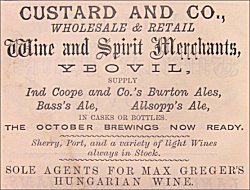 Mary died in
the summer of
1857 and in the
1861 census
Henry, aged 54
and a widower,
described his
occupation as
accountant and
was living in
Princes Street
with his son
George and a
domestic
servant.
Mary died in
the summer of
1857 and in the
1861 census
Henry, aged 54
and a widower,
described his
occupation as
accountant and
was living in
Princes Street
with his son
George and a
domestic
servant.
During the 1870s Henry was in partnership with his son George Waldron Custard as wine, spirits and ale merchants under the name of Custard & Co. The partnership was dissolved by mutual consent in March 1879 after which George Custard carried on the business on his own. In the 1891 census Henry was listed at 25 Princes Street. By now he was aged 84 and described himself as a 'Gentleman'. He was living with his accountant son George and his family as well as a general domestic servant.
Henry Marsh Custard died in the autumn of 1895 aged 89.
Gallery
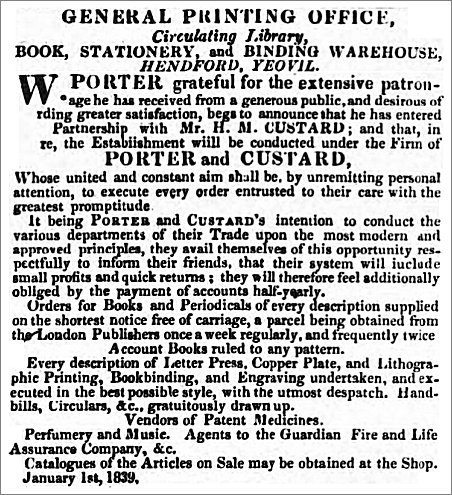
A notice placed in the 10 January 1839 edition of the Somersetshire Gazette announcing the partnership of Porter & Custard. It is interesting to note (at the bottom of the advertisement) that a sideline was dealing in 'Patent Medicines, Perfumery and Music'.
Below are two hand-tinted stone lithographs by Henry Burn (1807-1884). There are not many known stone lithographs by Henry Burn because he left for Australia in 1852. These two lithographs, both of 1839, are amongst the earliest known works by Burn whose other known works date from the 1840s. Both lithograph prints were published by William Porter and Henry Marsh Custard in January 1839 (and consequently among the first items published by Porter & Custard) and printed by Charles Joseph Hullmandel (1789-1850) of London, where he maintained a lithographic establishment on Great Marlborough Street from about 1819 until his death.
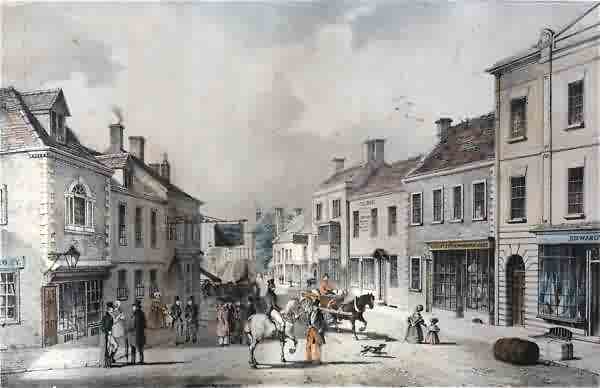
From my
collection
This subtly-coloured, and remarkably accurate (when compared with early photographs), lithograph of 1839, entitled 'Market Place - Yeovil', looks down High Street from its junction with Hendford / Princes Street. On the left the Mermaid with its familiar archway and large overhanging sign is clearly seen. On the opposite side of the road, just right of centre, the white three storey building with the two-storey projecting bay is the Kings Head Inn. It is likely that the two storey building next to the Kings Head Inn is the building that held the former George Inn.
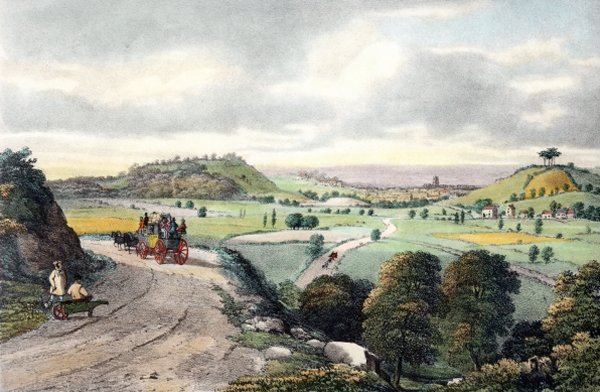
From my
collection
'View of Yeovil from Babylon Hill' in a stone lithograph also by Henry Burn (c1807-1884) and again published by William Porter and Henry Marsh Custard in 1839. With Summerhouse Hill at left, with Penn Hill behind it, surmounted by Penn House, and Wyndham Hill at right. The buildings at Pen Mill are seen at the base of the latter, with the tower of St John's church above and to the left. At centre, a horse-drawn cart is seen on the Sherborne Road before it was re-aligned.
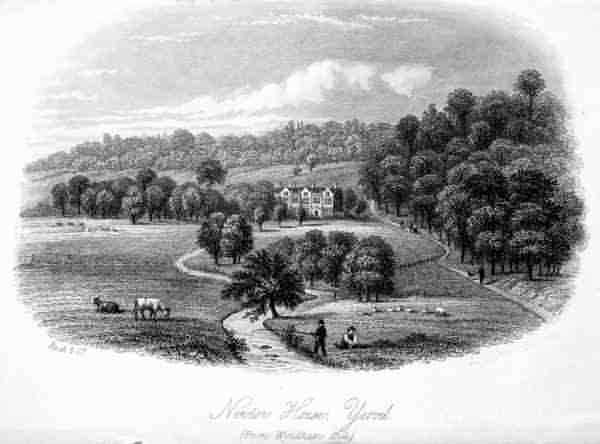
A steel vignette of Newton House in its parkland setting, as seen from Wyndham Hill. Engraved by Rock & Co of London and published by Henry Marsh Custard of Yeovil after 1841 when he split with William Porter.
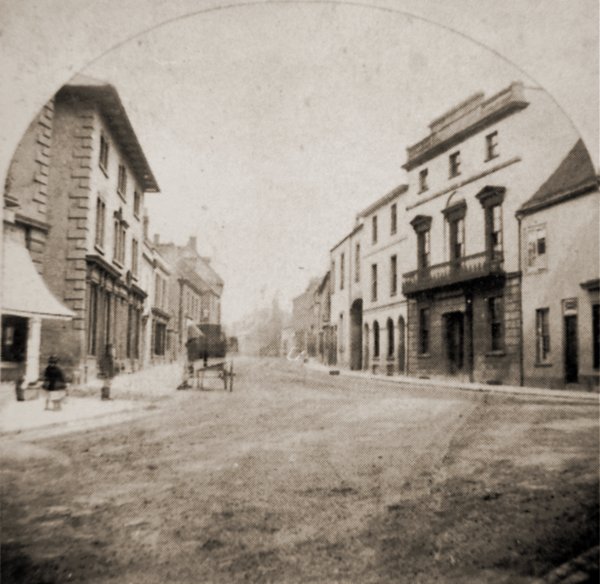
This photograph of Princes Street dates to around 1875 and is one half of a stereoscopic pair. It was taken at the time Henry Marsh Custard was running his bookshop / printer's / stationers which was situated in the three-storey building to the left of the cart in the photograph. The narrow lane seen between Custard's building and the building at extreme left was colloquially known as Custard's Lane and later widened to become Westminster Street.